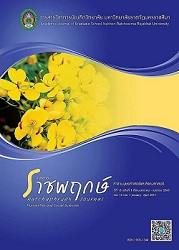ผลการจัดกิจกรรมการเรียนรู้โดยใช้วิธีการแบบเปิดที่มีต่อความสามารถในการแก้ปัญหาทางคณิตศาสตร์ ของนักเรียนชั้นมัธยมศึกษาปีที่ 2
Main Article Content
Abstract
การวิจัยครั้งนี้มีวัตถุประสงค์เพื่อศึกษาความสามารถในการแก้ปัญหาทางคณิตศาสตร์ของนักเรียน ที่เรียนด้วย กิจกรรมการเรียนรู้โดยใช้วิธีการแบบเปิด กลุ่มเป้าหมายเป็นนักเรียนชั้นมัธยมศึกษาปีที่ 2 โรงเรียนวัดมะม่วงตลอดจังหวัด นครศรีธรรมราช ปีการศึกษา 2558 จำนวน 8 คน ใช้ระเบียบวิธีวิจัยเชิงคุณภาพเครื่องมือที่ใช้ในการวิจัย ประกอบด้วย 1) แผนการจัดการ-เรียนรู้โดยใช้วิธีการแบบเปิด จำนวน 7 แผน 2) แบบบันทึกพฤติกรรมภาคสนาม 3) กรอบแนวทาง การบันทึกวีดิทัศน์การวิเคราะห์ข้อมูลโดยการวิเคราะห์โพรโทคอลและการบรรยายเชิงวิเคราะห์ตามแนวคิดของครูลิค และ รูดนิค ผลการวิจัย พบว่า นักเรียนมีความสามารถในการแก้ปัญหา ทางคณิตศาสตร์ 5 ขั้นตอนคือ 1) ขั้นการอ่านนักเรียน แสดงพฤติกรรมการอ่านแบบสังเกตคำสำคัญ พบในขั้นการเรียนรู้ด้วยตนเองและการนำเสนอปัญหา 2) ขั้นการสำรวจ และวินิจฉัย นักเรียนแสดงออกโดยการวาดภาพพบในขั้นการเรียนรู้ด้วยตนเอง 3) ขั้นการเลือกยุทธวิธี นักเรียนใช้แนวทาง เดียวในการแก้ปัญหา และเมื่อคุ้นเคยกับสถานการณ์ปัญหา นักเรียนจะมีแนวทางที่หลากหลายเพื่อใช้ในการเลือก แก้ปัญหาพบในขั้นการเรียนรู้ด้วยตนเอง 4) ขั้นดำเนินการแก้ปัญหา นักเรียนดำเนินการตามวิธีที่เลือกไว้ พบในขั้นการ เรียนรู้ด้วยตนเอง และ 5) ขั้นการทบทวนและขยายผล นักเรียนแสดงพฤติกรรมการตรวจสอบคำตอบการขยายแนวคิด ผ่านกิจกรรมการนำเสนอ การอภิปรายร่วมกับเพื่อนและครู พบในขั้นการอภิปรายทั้งชั้นและการเปรียบเทียบ และขั้นการ สรุปเชื่อมโยงแนวคิดของนักเรียน
The Effects of Open Approach Based Learning Activities on Mathematical Problem Solving Ability of Mathayomsuksa 2 Students
This research aimed to study Mathayomsuksa 2 students’ mathematical problem solving ability after learning through Open Approach on lesson of Parallel. The target group consisted of8Mathayomsuksa 2 students of 2015 academic year, in Watmamaungtalod School, Nakhon Si Thammarat. Qualitative Research design was applied. Research tools were: 1) 7 lesson plans with Open Approach activities, 2) Field behavior record form, 3) Video recording framework and they were analyzed by Protocol Analysis and Analytic Description based on the concept of Krulik and Rudnick. The results showed that students had mathematical problem solving ability; 1) Reading: students could identify the key words, while they did self-learning and posing open-ended problem step, 2) Exploring: students expressed through drawing, found in the students’ self-learning step, 3) Selecting a strategy: students used convergent solution to solve the problems and used divergent solutions, when they were acquainted, and also found at the students’ self-learning step. 4) Solving: students implemented the selected method, which was found in students’ self-learning step and 5) Reviewing and Extending: students showed their checking answers behavior, extended the concept through the presentation, discussed with friends and teachers, which found at the whole class discussion and comparison step also students’ emergent mathematical ideas summing-up.


